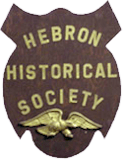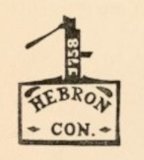
The Hebron Historical Society
Hebron, Connecticut
Enjoy Hebron - It's Here To Stay ™


Enjoy Hebron - It's Here To Stay ™

Immigration and immigrants are hot topics in today’s world. Hebron has witnessed significant “newcomers” on basically 50-year intervals: the 1850’s; the first two decades of the 20th century; the 1950’s; and the 1990’s. Particularly interesting is the international immigrant influx from 1912 to 1920. Their influence is still with us today.
The Pagach family, with their Czechoslovakian background, moved to Hebron in 1912; the Kowalski’s from Poland came in 1918, followed shortly by their cousins, the Pomprowicz’s, in 1920. The Ukrainian Kulynyck family came in 1920. The Italian Barrasso and the Saglio families also came in the early 1920’s. At that same time, Hebron saw Jewish families moving into Hebron, such as the Garbich’s from Argentina and the Turshen’s from Poland. Many of these families and their descendents are still here today.
One family, the Hildings, originally from Sweden, kept exceptionally detailed records of their farm, leaving us with a unique bird’s-eye view of Hebron in the early 20th century. But it was the intermingling of the old and new Hebron that makes the family unique.
Like most immigrants, John and Carolina Hilding started out in New York. Working as a tailor, John longed to return to his Swedish farming roots. Ultimately, the Hildings purchased a farm in Spring Valley, and specialized in honey, chickens and eggs. Four sons (Charles, Samuel, Edward and Albert) and two daughters (Victoria and Stella) went to school and ran the farm as John continued to work in New York, returning to Spring Valley on the weekends.
John and Carolina decided to move to Connecticut in 1909, selling the Spring Valley farm and using the proceeds to purchase a farm in Columbia. Neighbors to the Clifford Robinsons, the Hildings operated a successful grain and dairy operation. The milk was hauled every day by horse and wagon to the Turnerville Depot, where it was taken by train to the New Haven Dairy. Two events shaped the course of Hilding family history while living in Columbia. First, they attended the Hebron Congregational Church, where they were befriended by longtime resident, F. Clarence Bissell. Second, they took their grain to Porter’s Grist Mill, and it was here that one of the sons, Albert, met his future wife, Ethel Helen Porter.
It’s not really known exactly why John and Carolina sold the Columbia farm in 1912 and moved to Pine Bush, New York. Their grandson, Win Hilding (who now lives in Storrs), believes there was a water shortage, which may have played a significant role in their decision. One can’t run a dairy farm without water! Whatever the reason, the Hildings took the $3000 profit from the sale of the Columbia property, and purchased the Pine Bush dairy farm. Milk was now delivered to the Borden Dairy Company, and monthly checks were carefully recorded.
A mere 15 months later, the Hildings decided to return to Connecticut, again for reasons truly unknown. Win Hilding writes, “Bad thunderstorms, poor soil, market problems or nostalgia for their friends in Connecticut made them decide to return.” The decision may have also been influenced by Bissell, their old friend, who offered to sell his 100 acre farm on Church Street for a very reasonable price.
The Bissell property was sold to the “Hilding Brothers” – not their parents – for $3250. Charles, by now a successful shipping broker for the R. F. Downing Company in New York City, conducted the negotiations. Bissell sent Charles a telegram on January 4, 1914: “Will meet you in Hebron Wednesday at three o’clock and complete the trade…bring certified check rather than currency… write me on Monday if this suits your convenience.” Charles then sent a telegram to his brother Sam on January 5th with a simple message: “Bissel [sic] accepts; await letter.”
Sam acted as official agent for the brothers, and on January 7, 1914, signed the sale papers in his elegant, 19th century-style handwriting. He put down $2000 in cash and agreed to a $1250 mortgage over five years at 5% interest. On January 12, Bissell (who was now living in Hartford and serving as Connecticut’s Deputy State Comptroller) wrote to the brothers that he had just moved out all his furniture, and that the current renter would vacate the property by April 1. “We are now having some very blustering cold weather and I think you are wise in not trying to move until later in the season,” he wrote. The three brothers, Sam, Ed and Albert, with parents and sister Victoria in tow, moved into the property in March 1914. Charles remained in New York.
Like all the immigrant families coming into Hebron, the Hilding brothers were hard workers. Sam and Ed were the apparent workhorses; Albert was not only hard-working, he was the record keeper and perhaps the genius behind the farm’s success. The interest payments were faithfully sent to Bissell every June and December, as outlined in the sale papers. Sam sent one payment, but Albert made all the others.
The first major task for the brothers was building a new dairy barn, a milk house, and an ice house, jobs that took them almost a year. Chestnut timbers from the Buell saw mill in Gilead were hauled by wagon, and concrete floors were poured. By February 1915, the brothers were back in the dairy business, once again selling milk to the New Haven Dairy Company, although it was no longer a happy business arrangement. Albert kept daily farm records, recording weather conditions, output of the cows and chickens, and payments made to laborers.
Albert, still enamored with the beautiful and vivacious Ethel Porter, married her in 1917. Ethel and her aunt, Ida (who ultimately married Dr. Charles Douglas), were among the most popular women in town. Ethel and Albert’s marriage, in many ways, was a perfect match. Ethel brought out the best in the quiet, serious Albert, and Albert brought deep love and commitment to Ethel. With Ethel at his side, Albert became an integral part of the Hebron community, especially the Hebron Library Board of Directors and the Hebron Congregational Church, organizations he served for 50 years. Ethel remained active in the Original Hebron Women’s Club, the Congregational Church and performed for local community theatre. Their three children, Winthrop, Alberta, and Lois, were the light of their parents’ lives.
If you look at the Hilding homestead (now the parsonage for Church of the Holy Family), it appears to be two homes, joined together by a center ell. Albert, Ethel and the children occupied the northern part of the home; John, Carolina, Sam, Ed, and Victoria occupied the southern part. The home was filled with people, but the layout of the house offered privacy and a living arrangement that worked well.
It was the egg and chicken business that ultimately made the Hilding farm successful. Why? “Monopolistic practices” by the big dairies led to very low profit levels (2 cents per quart) and milk production quotas. The brothers were early leaders in attempts to unionize other Connecticut dairy farmers, and were blacklisted by New Haven Dairy for six years. Right after this, Albert became a postal carrier for the Amston post office to supplement the family’s income, a position he held for 34 years. He became a local folk hero for delivering mail on the day that the 1938 hurricane devastated Hebron.
With the advent of electricity, and using incubators purchased from Montgomery Ward, the brothers soon realized that the profit was in selling chicks. They ended the dairy business ended permanently in 1943. Two years later, the brothers had expanded the chicken coops to two stories, with a capacity of 2000 laying hens. The chicken and egg business continued successfully until the farm was finally sold to Harry Megson in 1965.
John and Carolina died at the homestead and are buried in Hebron. Ed, Sam, and Victoria never married; their life was the farm. Charles eventually purchased a home on Church Street (now owned by the Haydon family), just north of his brothers, and was a frequent visitor to Hebron. The surviving Hilding family members, Sam, Ed, Albert and Ethel and their children, then moved to new homes on Chestnut Hill Road, land that had once been owned by Ethel’s father, Henry Clinton Porter.
The Hilding farm is referred to today as the “Johnson” property, a site purchased by the Town of Hebron a year ago for open space and recreation purposes. But for over 50 years, three brothers worked the land and became an integral and welcome part of our community. What an example they have set for us, the 21st century wave of “newcomers.”